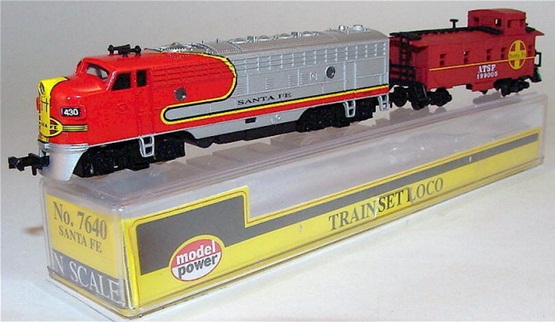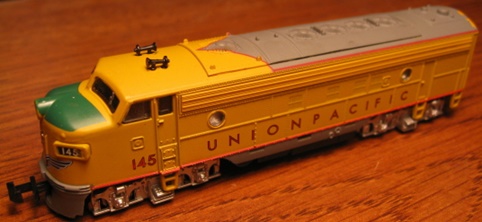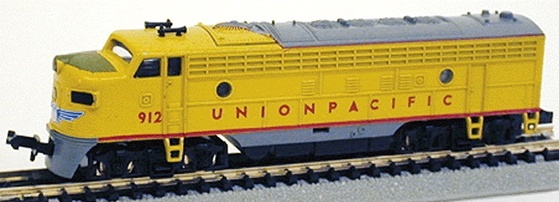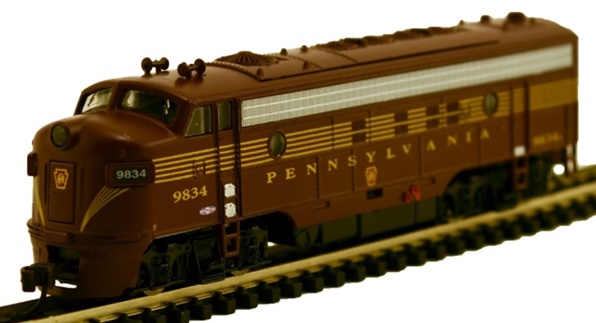

Introduced: 2001 (Chinese-made Model Power "Trainset" Version), 2006 (Korean-made Model Power "Modeler" Version), and 2018 (Chinese-made MRC Version)
The original Model Power releases of these models came in two distinctly different flavors. The first was the "Trainset" version (manufactured in China) -

The second Model Power release (the so called "Modeler / Hobbyist" version) was manufactured in Korea by Ajin. As pictured below, it was available in two different "phase" variants -
| Phase 1 | Phase 2 |
 |  |
Both models have similarly sized and shaped metal shells, however the Modeler version has slightly finer paint and detailing (UP=Modeler version, ATSF=Trainset version) -
The internal differences are even more striking -

Modeler version
Both versions have a one-piece / all-metal chassis (wow, I'm having a 1980s Roco flashback), and both versions have their motors buried under an unsightly piece of duct tape. The motors are not the same between the two versions (I'm not sure what the internal specs are on the Trainset version, but the Modeler version has a 3-pole / skew-wound motor). Both versions have dual flywheels, although the flywheels on the older Trainset version are actually larger than on the Modeler version. Both versions have all-wheel propulsion and pickup (by way of wired wheelback wipers). There are no traction tires. All of the gearing is plastic. Trucks are held to the chassis by way of knock-out pins. Both versions route their current around via an ugly rat's nest of wiring, and both versions have non-directional headlights mounted to the front of the chassis.
Where things start to diverge is in the worm area. The Trainset version has old-school swivelling truck-towers, whereas the Modeler version has worms that are firmly fixed inside of pockets in the chassis (no bearing blocks, though). The coupler situation between the two versions is quite different as well. The Trainset version has a truck-mounted Rapido on the back and an extremely specialized Rapido-style coupler screwed directly to the front of the chassis. Conversely, the Modeler version has chassis-mounted coupler pockets on both the front and back (still Rapidos, though). The Trainset version's wheels are oversized (Code-55 = No), whereas the Modeler version's wheels are not (Code-55 = Yes).
Both versions use the fuel tank to hold the shell to the chassis. IE, remove the fueltank and the shell lifts right off (you just have to finagle the front coupler through the hole in the pilot).
The Trainset version is a fairly mediocre runner. It has a funny, top-heavy wobble that I normally associate with traction tire equipped locomotives (although, as mentioned above, this locomotive is not so equipped). Overall performance isn't too bad, although it emits all sorts of odd, growly noises - particularly through curves. Slow speed performance is OK, albeit a bit jerky and uneven. The shells and fuel tanks tend to be very loose fitting, resulting in a very clanky ride as the shell bangs against the chassis. Overall, I wouldn't rate this locomotive any higher than Bachmann's old 1960s / 1970s era trainset models.
And from the "You can't make this stuff up" department - it appears that all of these Trainset FP7s have their motors installed "backwards". In other words, if you put one of them on the rails with another (different) locomotive and apply throttle, the two will move in different directions! When I discovered that mine had this problem, I asked around and confirmed that others do indeed have the same problem with their Trainset FP7's. Go figure!
My guess is that the non-Modeler FP7's were specifically designed for inclusion in cheapie Model Power train sets (in fact, that's exactly what it says on the box: "Train Set Loco"). And if you're asking, yes, I actually wasted eighty bucks on a crappy Model Power trainset just so I could get my hands on one of these crummy little locomotives. How's that for dedication?
Trivia - circa 2012, Model Power started selling ala carte "dummy" (no motor and no worm/idler gearing) Trainset FP7's from their website -

My suspicion is that these were actually returned models that Model Power ripped the guts out of and resold; this based on the fact that the one I got appears to actually have been used (gunk, dust and fibers in the axle gears and inside the chassis, etc). It also didn't come in any sort of box. But hey, for ten bucks it is what it is.
The modeler / hobbyist version was released in 2006, and as noted above it was available in two different phases (with the differences between the two phases being pretty minimal - basically boiling down to minor variations in the side vents and the dynamic brake fans). Like the Trainset version, the Modeler version doesn't have any specific provisions for DCC (apart from the fact that the motor is electrically isolated from the frame). And although Model Power's website did at one time claim that DCC versions (with preinstalled decoders) were in the works, they went out of business before that ever happened.
Performance on the Modeler version is actually much improved over the original. Throttle response is smooth, pickup is fine, and slow-speed creep is great. The top-end is easily half that of the Trainset version, and no more wobbling (or any of that other twitchy trainset loco stuff). Pulling power is quite good, with mine able to haul fifteen 85' Kato passenger cars around like they're not even there. Although not a particularly quiet runner (having a bit of a gear growl to it), it's not too horrible - basically they generate a distinctive sound, but not a particularly distracting or unpleasant one (direct from the hair-splitting department). Overall, not a bad locomotive at all. And given the model's relatively low list price, it certainly has (had) its place in the N scale locomotive pantheon. However, given the 1970s-esque pickup/wiring scheme (not to mention those nasty old Rapido couplers), I can't quite give it an "A" rating.
As noted above, Model Power went out of business in 2014 (with their product line then being acquired by MRC). In 2018, MRC released slightly revised DC versions of the Modeler FP7 (now made in China). The only discernable changes are to the couplers (E-Z Mate automatic/magnetic couplers instead of Rapidos) and to the headlight (now an LED board with directional lighting instead of a nondirectional bulb) -

MRC also released DCC-Sound versions of the FP7 around this same time. As pictured below, the back end of the chassis was modified slightly to provide room for the speaker. The decoder ("elegantly" insulated with scotch tape) is simply connected to the existing wiring for track power, motor control and headlight control. The decoder appears to have been specifically designed for this model as it's basically press-fit around the motor (with the motor saddle fitting snugly inside notches on the decoder board).

Although the wheels are blackened, this doesn't appear to interfere with locomotive performance (not on mine, anyway).

Not surprisingly, overall performance on the sound version is basically the same as the analog version (solid, but a bit noisy). Unfortunately, this may be the least impressive DCC-Sound implementation I've ever encountered. I kid you not, when I first put this thing on the rails I thought I'd accidentally received one of the DC versions, what with the noises it was making sounding very much like the whiny racket an analog loco makes when you put it on AC rails. But no, all that tinny hissing and whining is supposed to be the sound of a diesel engine. Making matters worse, the speaker doesn't have any sort of enclosure and precious little exposure to the outside world (the tiny window in the rear door being its only opening), so once the loco starts moving the gear noise basically drowns out the speaker entirely (even at maximum volume). So, no, not good. I think most people will be severely disappointed with the DCC-Sound version (especially after shelling out $100+ for one).
In 2019, Heartland Hobby purchased the tooling for the old Model Power line of N scale locomotives from MRC. It's anyone's guess what (if anything) they plan on doing with it, but it's entirely possible that we've seen the last of them.
Grades: C (for the Model Power Trainset version), B (for the Model Power "Modeler" version), B (for the MRC analog version), and C (for the MRC DCC-Sound version)